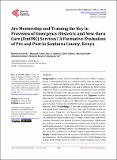| dc.contributor.author | Majiwa, Fredrick | |
| dc.contributor.author | Mukami, Diana | |
| dc.contributor.author | Kiarie, Jackline | |
| dc.contributor.author | Kiilu, Colleta1 | |
| dc.contributor.author | Maithya, Ruth | |
| dc.contributor.author | Gikunda, George | |
| dc.contributor.author | Munyalo, Bonnie | |
| dc.contributor.author | Omogi, Jarim | |
| dc.date.accessioned | 2022-01-18T09:10:00Z | |
| dc.date.available | 2022-01-18T09:10:00Z | |
| dc.date.issued | 2021-12-28 | |
| dc.identifier.citation | Open Journal of Clinical Diagnostics, 2021, 11, 100-111 | en_US |
| dc.identifier.issn | ISSN Online: 2162-5824 | |
| dc.identifier.uri | https://repository.amref.ac.ke/handle/123456789/508 | |
| dc.description | Globally, thousands of women die annually from complications during the pregnancy,
childbirth and postpartum period, with most deaths occurring in developing
countries [1].
According to the World Health Organization (WHO), approximately 295,000
women died during and following pregnancy and childbirth in 2017 with 94% of
these deaths occurring in the low resources setting [2].
WHO reports that approximately 810 women die every day from preventable
causes related to pregnancy and childbirth. It also adds that neonatal deaths within
the first 28 days of birth are associated with the lack of quality care at birth or
skilled care and treatment immediately after birth. In addition, women who receive
care from professional midwives that have been trained to international standards
are 16% less likely to lose their baby, and 24% less likely to experience preterm
birth [3].
According to the Kenya Demographic and Health Survey (KDHS) 2014, the
Maternal Mortality Ratio (MMR) is 362 per 100,000 live births, and the neonatal
mortality rate is 23 deaths per 1000 live births. This is far below the target of 147
maternal mortality per 100,000 live births and 12 stillbirths per 1000 live births
respectively [4]. | en_US |
| dc.description.abstract | Background: In Kenya, the Maternal Mortality Ratio (MMR) is approximated
to 362 maternal deaths per 100,000 live births while the stillbirth rate
stands at 23 deaths per 100 live births which are far below the target of 147
maternal mortality per 100,000 live births and 12 stillbirths per 100 live births
respectively. Progress in addressing preventable maternal and newborn deaths
and stillbirths depend on the improvement of the quality of maternal, fetal
and newborn care throughout the continuum of care. Objective: To determine
the effect of mentorship and training in improving the provision of Basic
Emergency Obstetric Newborn Care (BEmONC) and Comprehensive Emergency
Obstetric Newborn Care (CeMONC) services among health workers in
Samburu County. Methodology: A one-week training intervention was carried
among health workers in level three, four and five health facilities by
master trainers. Using two tools adopted from MEASURE Evaluation and a
structured questionnaire, a total of 54 (before the intervention) and 64 (after
the intervention) health workers from 29 health facilities were interviewed.
Training effectiveness was assessed by means of questionnaires administered
pre- and post-training, by correlating post-training results of health workers,
and through participatory observations at the time of on-site supervisory visits,
mentorship and monthly meetings. An assessment was conducted to measure
the level of confidence of the health workers in performing their duties.
Results: Central Samburu had the majority of the health workers both at the
pre-intervention (44.4%) and post-intervention (51.6%), North Samburu had
an extra health worker at post-test while no change in numbers was recorded 10.4236/ojcd.2021.114008 101 Open Journal of Clinical Diagnostics
in East Samburu. A majority of the health workers across the three sub-counties
were 31 - 40 years old, with only 2 (3.8%) aged 51 years and above. Following
the interventions, improvements in the practice of BEmONC services
were seen across the three sub-counties. There was an increase, at post analysis,
in the use of the partograph to monitor labour (from 52% to 98.1%) and
managing severe infection in the newborn (from 40.4% to 60.3%). Performing
CS improved from 17.3% to 31% and the same was also recorded in carrying
out blood transfusions. On post-survey, health workers reported the
least confidence in performing manual vacuum. Other BEmONC services including
active management of 3rd stage labor, use of partograph, manual removal
of the placenta, managing maternal sepsis and identifying danger signs
in the newborn had a high rate of confidence. Conclusions: This study finds
that structured mentorship is an effective strategy to build the capacity of
health workers. However, there is a need for further research to monitor
and evaluate | en_US |
| dc.description.sponsorship | 1Amref Health Africa, Nairobi, Kenya
2Amref International University, Nairobi, Kenya | en_US |
| dc.language.iso | en | en_US |
| dc.publisher | Scientific Research Publishing Inc. | en_US |
| dc.relation.ispartofseries | Open Journal of Clinical Diagnostics;DOI: 10.4236/ojcd.2021.114008 | |
| dc.subject | Emergency Obstetric Newborn Care | en_US |
| dc.subject | Health Workers | en_US |
| dc.subject | Training | en_US |
| dc.subject | Mentorship | en_US |
| dc.title | Are Mentorship and Training the Key in Provision of Emergency Obstetric and New-Born Care (EmONC) Services? A Formative Evaluation of Pre and Post in Samburu County, Kenya | en_US |
| dc.type | Article, Journal | en_US |
| amiu.youtube.embedcode | NA | en_US |

